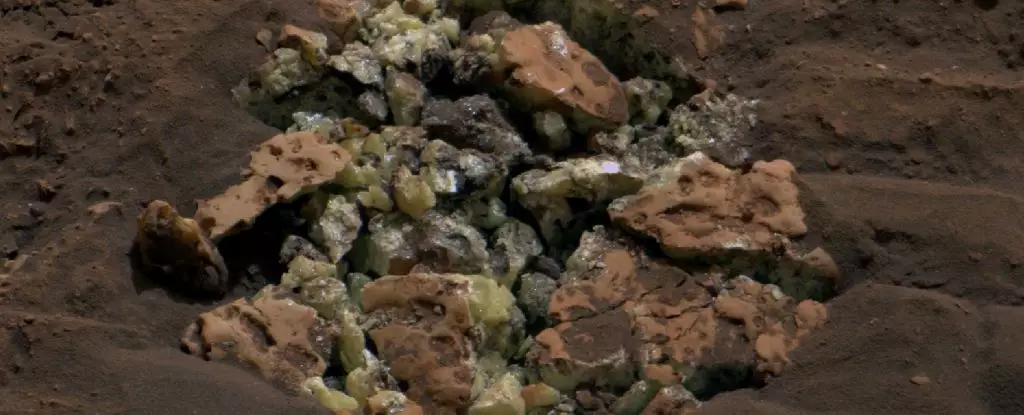The recent discovery of elemental sulfur on Mars’s surface marks a pivotal moment in planetary science, pushing the boundaries of our understanding of the red planet’s geological complexity. When NASA’s Curiosity rover accidentally fractured a seemingly ordinary rock in the Gediz Vallis Channel, the resulting reveal of bright yellow crystals—pure sulfur—defied expectations and opened new avenues of scientific inquiry. This unexpected find indicates that Mars’s surface chemistry is far more dynamic and possibly more hospitable to unique mineral formations than previously believed, prompting scientists to reconsider long-held theories about the planet’s geochemical history.
This discovery is particularly striking because pure elemental sulfur is rarely observed in planetary settings. While sulfates are commonplace on Mars and serve as markers of past aqueous activity, elemental sulfur suggests specific conditions that must have prevailed. It implies either unusual geochemical processes or transient environmental conditions that allowed sulfur to accumulate in its native form. The presence of such a mineral raises critical questions: How has the sulfur survived unnoticed until now? What processes could have produced or deposited such a mineral? Could this be evidence of previously unrecognized volcanic activity, geothermal phenomena, or other geological mechanisms?
These questions are not merely academic; they challenge the assumption that Mars’s surface is predominantly shaped by water-related processes and suggest the possibility of alternative pathways for mineral formation. The fact that the sulfur appears not just as isolated crystals but in large fields resembling an “oasis in the desert” hints at the presence of localized environments that fostered sulfur accumulation—environments that might have been more dynamic or habitable in the distant past.
Implications for Mars’s Habitability and Future Exploration
The elemental sulfur discovery deepens the intrigue surrounding Mars’s potential for past life. While sulfur itself is a fundamental element for living organisms—integral to amino acids and metabolic pathways—its mere presence does not confirm biological activity. Nevertheless, the find enhances the narrative that Mars once possessed, or perhaps still harbors, bio-relevant chemistry. It underscores the importance of scrutinizing these terrains for additional biosignatures or conditions conducive to life’s emergence.
Furthermore, the location of this find in the Gediz Vallis Channel—a site known for its ancient water flow—offers insights into Mars’s climatic evolution. Sulfur-rich deposits could be remnants of hydrothermal systems, where water interacted with volcanic activity, creating a chemically rich environment. If future missions can determine the mineral’s age and origin more precisely, they might reveal episodic events such as volcanic eruptions or underground hydrothermal vents capable of supporting microbial life, even if evidence of such life remains elusive.
The discovery also emphasizes the importance of in-situ analysis in planetary exploration. Had Curiosity not inadvertently cracked this mineral, the pure sulfur might have remained hidden for much longer. It underscores how critical chance and serendipity are in advancing science—yet it also highlights our dependence on robust instrumentation and strategic exploration routes. As we plan for future missions, deploying more sophisticated tools designed to detect elusive minerals will be vital to uncovering Mars’s secrets more systematically.
The Scientific and Technological Horizon
In response to this groundbreaking find, planetary scientists are now motivated to develop more refined models of Mars’s geological history. Understanding how pure sulfur could form and persist prompts a reevaluation of the planet’s volcanic and geothermal activity timelines. Could volcanic eruptions or underground heat sources have played a more significant role than previously acknowledged? Or do these sulfurs represent mineralization from ancient atmospheres or other unknown processes?
Moreover, this discovery fuels optimism about the feasibility of future sample-return missions. If fragments of pure sulfur are visible on the surface, retrieving these samples could offer more definitive evidence regarding their origin and the conditions that fostered their formation. These samples might contain isotopic signatures that concretely tell stories about Mars’s past environments, climate fluctuations, and geochemical cycles.
Finally, it challenges explorers and scientists to think more creatively—perhaps to look beyond traditional aqueous models and consider alternative scenarios involving volcanic or geothermal activity, which could create mineral deposits resistant to alteration over billions of years. Such thinking is essential if humanity is to truly unravel the complex history of Mars and assess its potential to have supported microbial life.
In essence, the accidental discovery of elemental sulfur on Mars underscores the importance of curiosity-driven exploration and the need to remain open to surprises. It reminds us that entire worlds can still hide their secrets just beneath our grasp, and each unexpected find pushes us closer to understanding our cosmic neighbor’s true nature.

